15 Best Things to See and Do in Tuscania, Italy - Essential Guide to Timeless Treasures
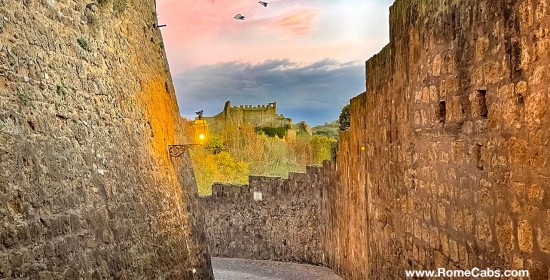
PRO TIP: If you are looking for the best things to see and do in Tuscania, Italy, save this page in your "Italy Trip" folder for easy reference. Be sure to visit our Rome Countryside Tours for exciting day trips from Rome and Italy Transfer Services for transfers to and from Tuscania.
Buongiorno and welcome to RomeCabs, Rome’s top-dated tour company for private Italy tours and Shore Excursions from Civitavecchia. Tuscania, a charming town nestled in the heart of Tuscia —a captivating region in the northern part of Lazio— is featured in two of our Rome Countryside Tours: Mysterious Etruscans and Medieval Magic Countryside Tour (as well as Post-Cruise Medieval Magic from Civitavecchia).
Approximately 1 hour and 30 minutes north of Rome and about 40 minutes from Civitavecchia, Tuscania holds significant historical and geographical importance. This region, once part of ancient Etruria, the name of the land of the Etruscans who settled here, is now commonly known as Tuscia. Tuscia encompasses the cultural and historical treasures left behind by the Etruscans in towns such as Tuscania, Tarquinia, and Viterbo.
From the early Etruscans to the Renaissance, Tuscania boasts a rich history, marked by stunning architecture and a vibrant cultural scene. In this enchanting destination, there's a plethora of things to see and do in such a small town of about 8,000 inhabitants.
Before we embark on exploring the wonders of Tuscania, let's delve into its rich history, visible in the town's remnants and woven into its vibrant culture. A deeper understanding of its past provides valuable insights into the present charm of this captivating town.
Join us on this immersive journey through Tuscania's historical and cultural treasures.
Tuscania Through the Ages: A Journey in Time
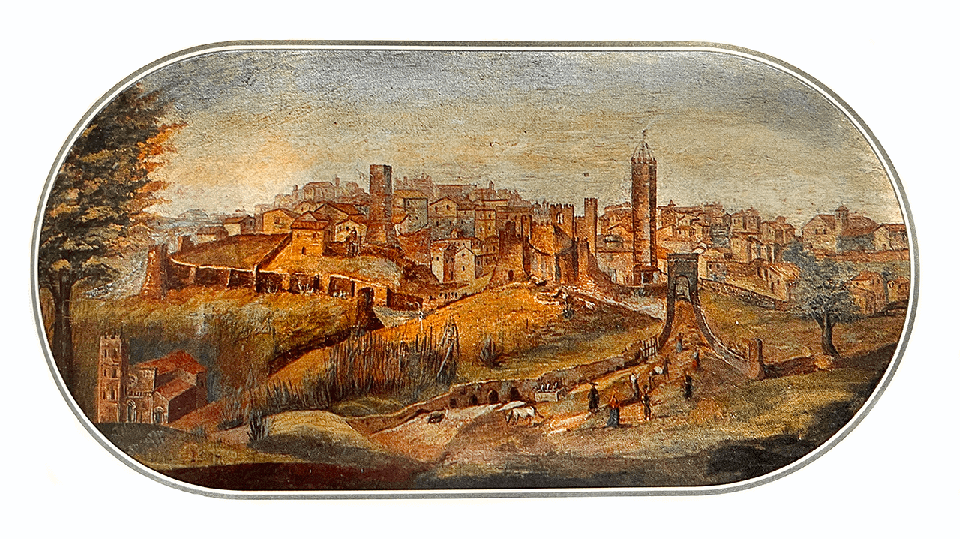
Ancient Etruscan through the Roman Empire Eras
According to legend, Tuscania's founding is ascribed to Ascanius, son of Aeneas, who discovered twelve dog pups (hence the Etruscan name "Tus-Cana", with "cana" resembling the Latin "canis" for "dog").
Another legend attributes the city's establishment to Tusco, son of Hercules and Araxes. As linguistic evolutions unfolded, this name transitioned into Latin, where it became "Tuscanum". Until the late 19th century, Tuscania was known as Toscanella - a name given during the Middle Ages.
While evidence of human presence in the area dates back to the Neolithic age, Tuscania likely took shape as a city in the 7th century BC when the acropolis on St. Peter's Hill was fortified with surrounding walls. Although villages existed nearby, the strategic location of Tuscania elevated its significance in the Etruscan world.
Dating back to the 7th century BC, Tuscania's history unfolded through seven settlements, strategically positioned on the hills south and north of the present-day Colle San Pietro (Saint Peter Hill). This hill becomes the epicenter of the territory, a religious-commercial reference point for adjacent dwellings and a broader area spanning at least ten kilometers.
In contrast to other ancient Etruscan centers, Tuscania's evolution into a unified hub occurred gradually, stabilizing from the second half of the 4th century BC. Economic trade intricacies at this crossroads introduce cultural influences, alternately promoting and hindering the physical-political unity of the center.
During the early archaic phase, Tuscania became part of Tarquinia's territory, evident in the frequent use of ogival tombs. The contemporaneous use of dado and semi-dado tombs places Tuscania in the culture of early rock tombs, with influences from Cerveteri.
Signs of other cultures, including Vulcente, Vulsiniese, Chiusina, and Greek, emerge through imported ceramic artifacts. From the late 4th to the 3rd century BC, Tuscania reached its zenith, centered around the Colle San Pietro, Rivellino, and Poggio Fiorentino, forming a city. This period witnessed the extensive use of Nenfro sarcophagi with lifelike portraits, foreshadowing Roman portraiture.
The Etruscan necropolises surrounded the settlement, especially in the northeastern quadrant on the slopes of the two hills flanking the Fosso del Maschialo (Peschiera and Piano di Mola) and in the southern one (locations Scalette and Madonna dell'Olivo) testify to the presence of the Etruscans in this area.
Etruscan sarcophagi are so abundant in Tuscania that they also adorn squares and places of interest such as the Basilica of Saint Peter.
Roman conquest solidified in 285 BC with the occupation of Tuscia, establishing Tuscania as a crucial stronghold. Becoming a municipium of Roman Italy at the beginning of the 1st century BC, Tuscania retained some importance throughout the imperial age as a "station" along the Clodia road.
Tuscania during the Middle Ages through the Renaissance
In the early Middle Ages, it thrived as a flourishing diocese, and its economic and social life retains a Lombard imprint. At the end of the ancient world, Tuscania suffered devastation and occupation by the Eruli and Goths. Then, after being contested between the Byzantines and Lombards, it was under Lombard rule for two centuries before passing to the Church's Patrimony in 774.

The city likely occupied only the southern part (Colle del Rivellino) of the site where the medieval and modern city later expanded, possibly extending to the hill immediately southeast (Colle di San Pietro or Civita, where the two Romanesque churches of Santa Maria and San Pietro were built).
The 13th century brought internal strife among the Ghibelline and Guelph families, and new public monuments emerged. The cityscape expands with numerous castles in the Tuscanian territory, stimulating economic initiatives. In 1300, Tuscania was occupied by the forces of Campidoglio, a decisive episode in Tuscania's history.
Despite challenges like famines and the Black Death in 1349, the city transformed. In the 15th and 16th centuries, wealth from agriculture flooded in, leading to the construction of late Renaissance palaces and the beautification of the city with baroque fountains.
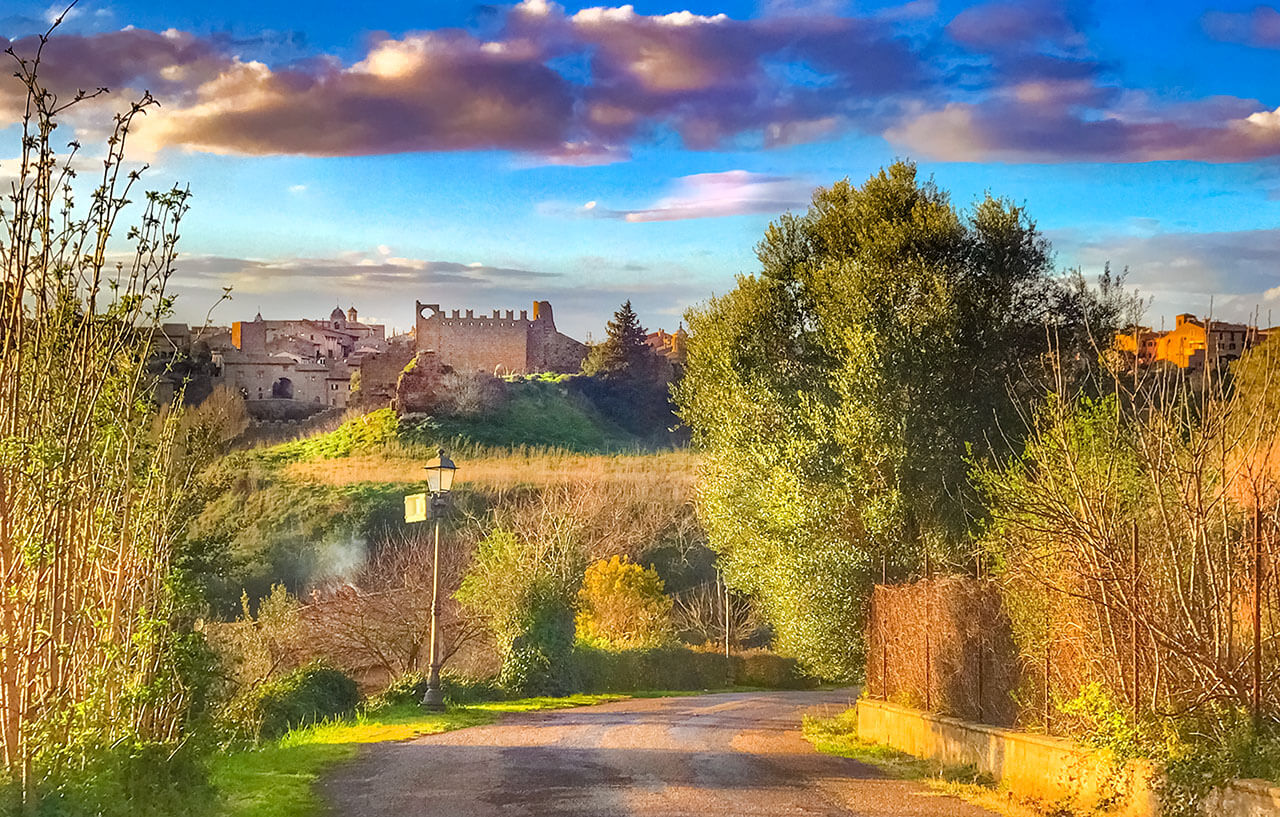
Tuscania during modern times
While the 18th century lacked grand public works, the 19th century saw an economic resurgence, reflected in archaeological excavations. On September 12, 1870, the Kingdom of Italy inherited Tuscania from the Papal State. A strong local spirit, rooted in ancient traditions, persists through festivals and local folklore.
On February 6, 1971, at 7:09 PM, an earthquake devastated parts of Tuscania, which since have been restored.
15 Best Things to See and Do in Tuscania
1. Medieval City Walls and Towers
The medieval walls and towers of Tuscania are a testament to the city's rich history and architectural legacy. Dating back to the Middle Ages, these fortifications played a crucial role in protecting the city and its inhabitants.
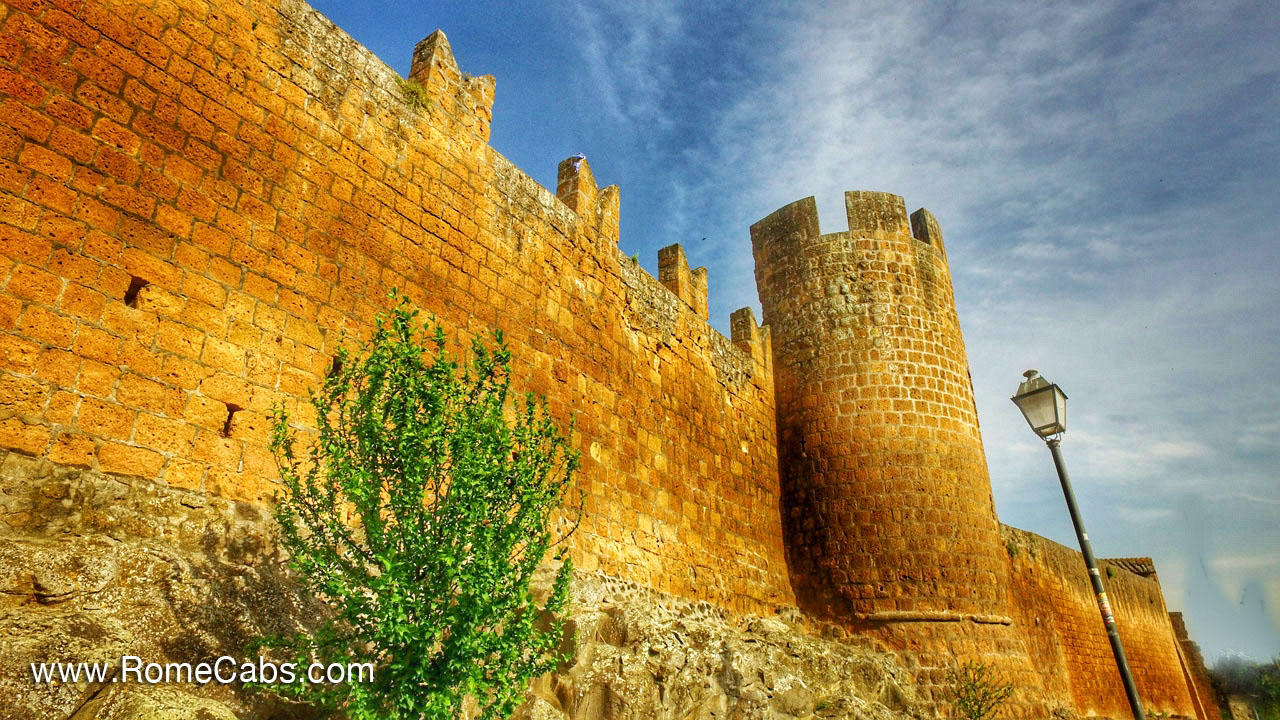
The construction of the medieval walls began in the 12th century as Tuscania sought to fortify itself against external threats. These walls were continuously expanded and reinforced over the centuries in response to various conflicts and changing military strategies. They were designed not only for defense but also to assert the city's political and social significance.
The walls of Tuscania are predominantly constructed with local materials, often using the characteristic volcanic stone known as nenfro and strategically positioned to encircle the city, following the natural contours of the landscape.
Integrated into the walls, defensive towers served as essential components of Tuscania's medieval fortifications. These towers were constructed at strategic points along the walls, providing elevated vantage points for surveillance and defense. The towers vary in design and height, showcasing the architectural diversity of different periods of construction.
Numerous towers dot the historic center of Tuscania, and intriguingly, these structures weren't erected for defensive purposes. Instead, they served as tangible symbols of opulence and influence, constructed by affluent individuals seeking to flaunt their wealth and power through the creation of tall towers —a kind of medieval skyscraper common in many medieval towns such as San Gimignano, Siena, Tarquinia, and more!.
Most of these towers have been reduced in height, either by succumbing to structural deterioration over time, or intentional reduction orchestrated by adversaries keen on diminishing the stature of their foes. Nowadays, many diminished medieval towers have undergone a transformation into residential dwellings, and you can easily discover several strolling through Tuscania’s medieval center.
Torre di Lavello
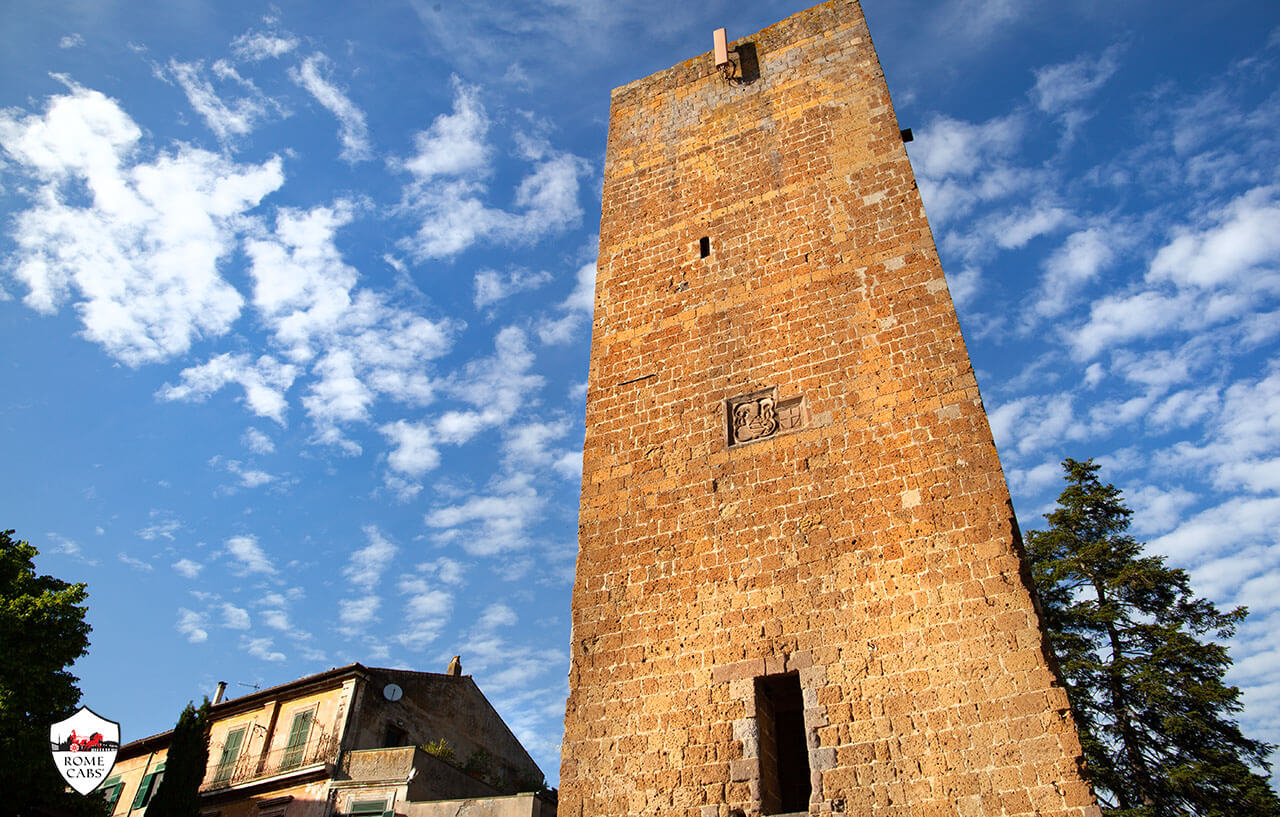
Built in Tuscania's historic center next to the park that takes its name, Torre di Lavello stands prominently at the park's entrance. Named after Angelo Broglio da Lavello, Tartaglia, an esteemed Mercenary Captain and illegitimate son of the Prince of Taranto, the tower bears the family's coat of arms, featuring a Gothic-style latticed square with a half-lion rampant and Broglio cords bearing the initials T and A. This historic structure, echoing Tuscania's fate, lost its symbolic "head" in 1166 due to a papal decree.
2. Tuscania’s Archaeological Heritage on Colle San Pietro (Saint Peter’s Hill)
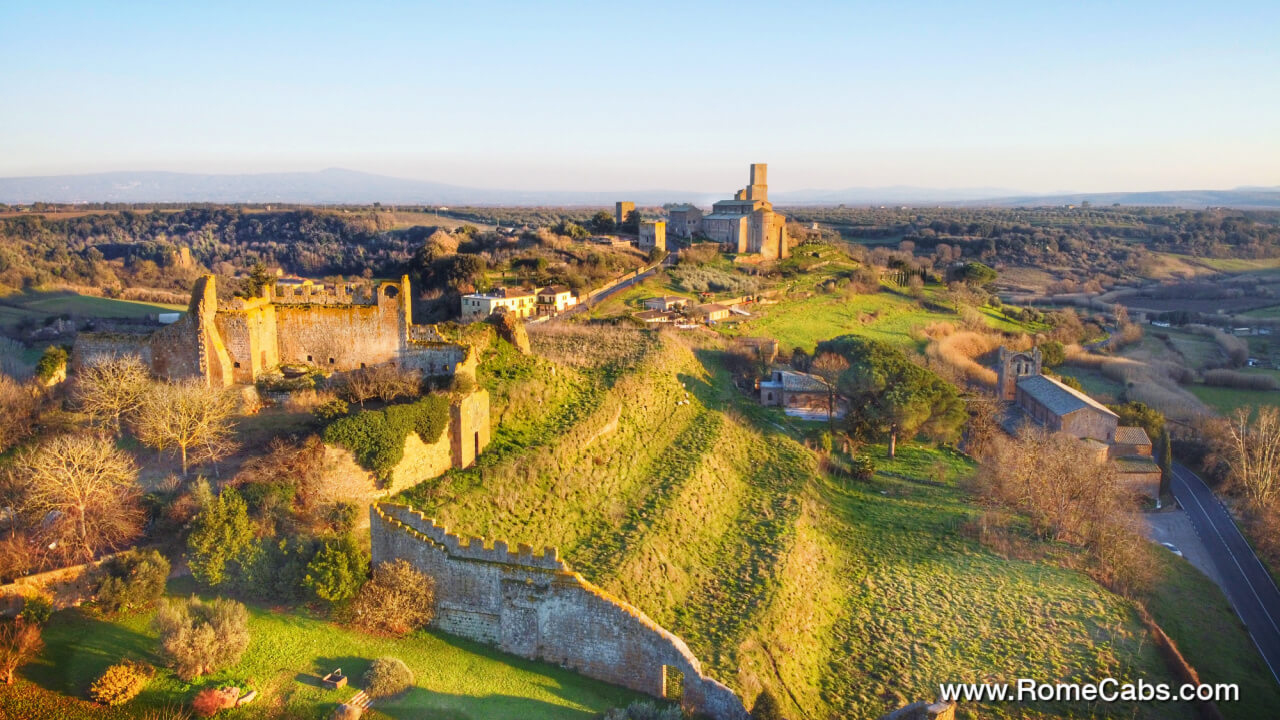
Stroll or drive (or if you are on one of our Rome Countryside Tours, your personal driver will take you as part of our tour itinerary) up the majestic Colle San Pietro (Saint Peter’s Hill) just outside the ancient city walls. During ancient times, this hill was an acropolis, sacred to ancient civilizations that settled here.
The historical significance of Tuscania, shaped by the Roman conquest and its strategic importance along the Via Clodia, is reflected in the archaeological site at Colle di San Pietro. Unearthed within this site are various Ancient Roman ruins, showcasing remnants such as an Augustan-era domus adorned with intricate plaster and mosaic floors, along with the vestiges of a thermal complex.
The 11th-century Romanesque basilica of Saint Peter atop Colle San Pietro serves as a testament to the eventual historical evolution from the Roman to the Medieval era, highlighting its religious and political importance. A visit to Colle di San Pietro provides a captivating journey through time, offering a glimpse into the enduring spirit of this ancient town.
3. Basilica of Saint Peter (San Pietro)
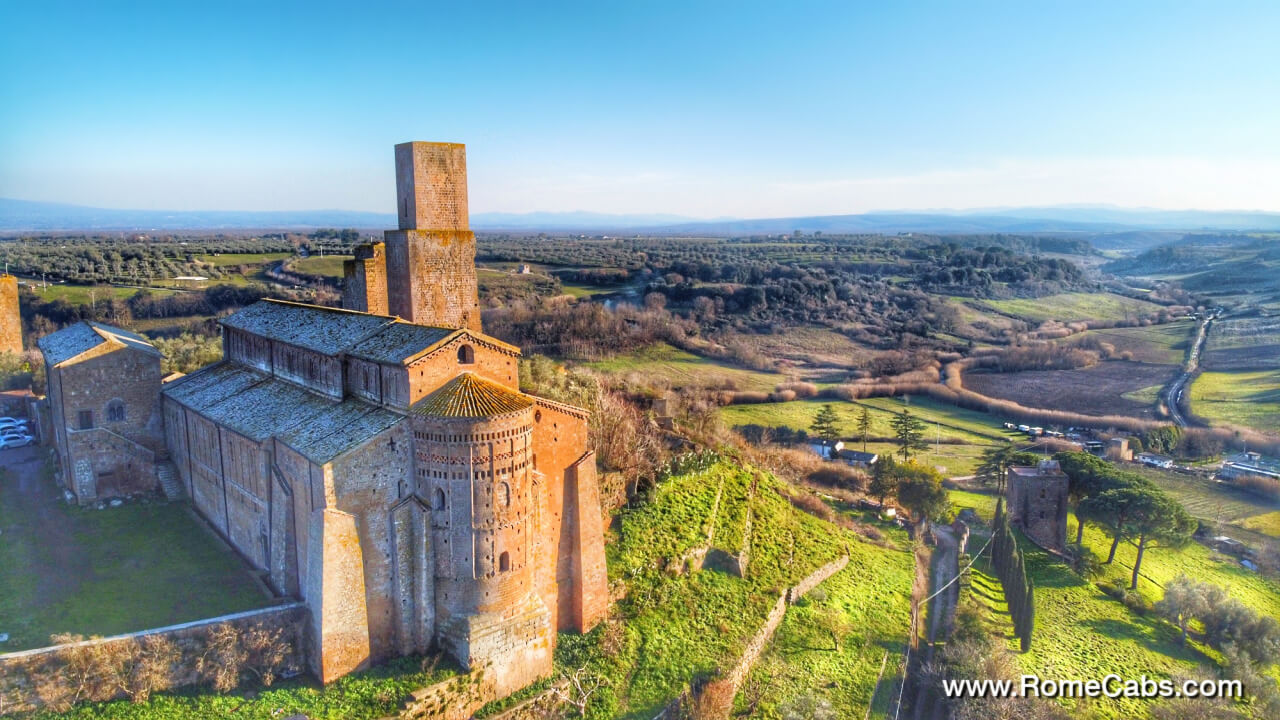
While on top of Colle San Pietro (Saint Peter Hill) be sure to visit the Basilica of Saint Peter (San Pietro). It is believed to have been originally constructed in the 8th century, although some elements suggest an even earlier origin. The church stands as a testament to the rich history of Tuscania, which was an important Etruscan city before the Roman era.
During the medieval era, Tuscania experienced a period of prosperity, and the Basilica of San Pietro likely played a vital role in the religious and social life of the community. Over the centuries, the church underwent various renovations and modifications, reflecting the changing architectural styles and religious practices of different periods.
The architectural style of the Basilica of San Pietro is predominantly Romanesque, characterized by sturdy construction, rounded arches, and a focus on symmetry and simplicity. The facade of the Basilica of San Pietro in Tuscania boasts a central portal adorned with three recesses, smooth columns, and archivolts featuring mosaics and decorative blocks. The rose window above is surrounded by sculptures representing the Evangelists and flanked by winged griffins.
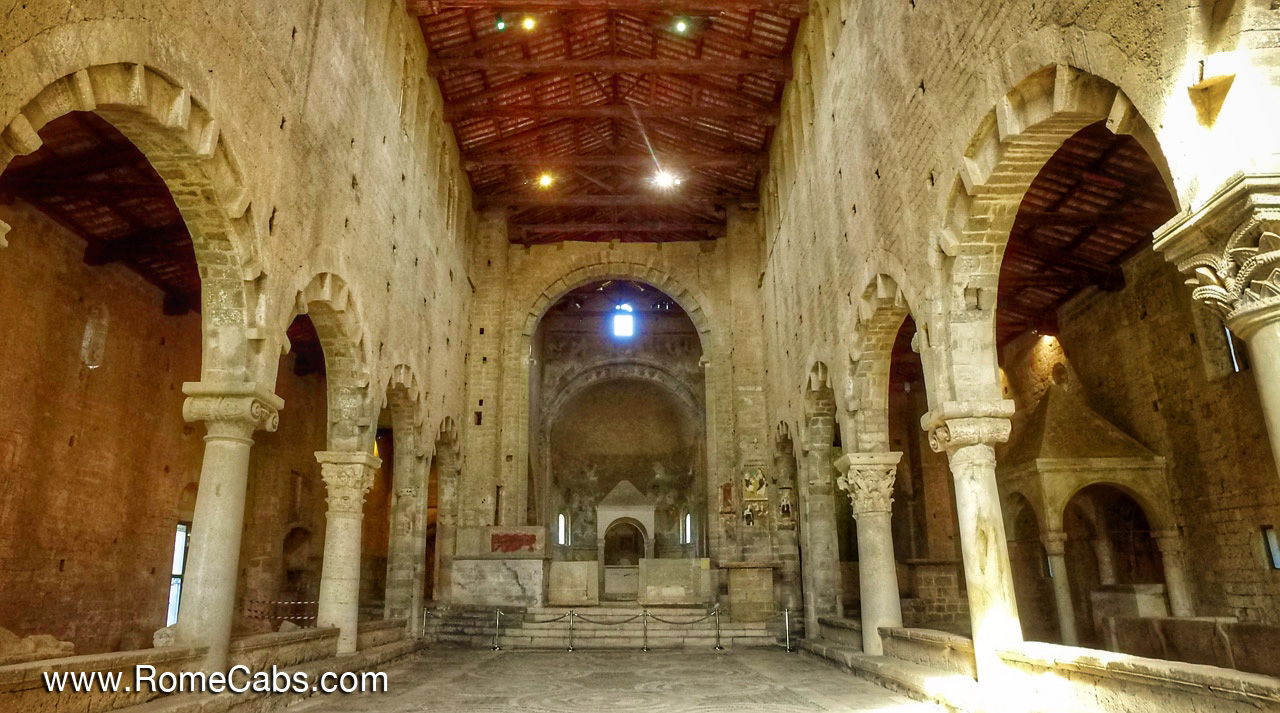
The interior, divided into three aisles, exhibits a Cosmatesque floor and a raised presbytery housing a ciborium and an episcopal seat. Unfortunately, much of the original pictorial decoration, including a Christ Pantocrator fresco, was lost in the 1971 earthquake.
The crypt dates to the 12th century, much later than the layout of the original church. The 28 columns support small cross vaults and feature a Madonna Enthroned among Angels and a 14th-century fresco of the Patron Saints of Tuscania attributed to Gregorio d'Arezzo. The columns were salvaged from Roman buildings, you can see sections of reticulate masonry in opus reticulatum (a facing used for concrete walls in early Ancient Roman architecture).
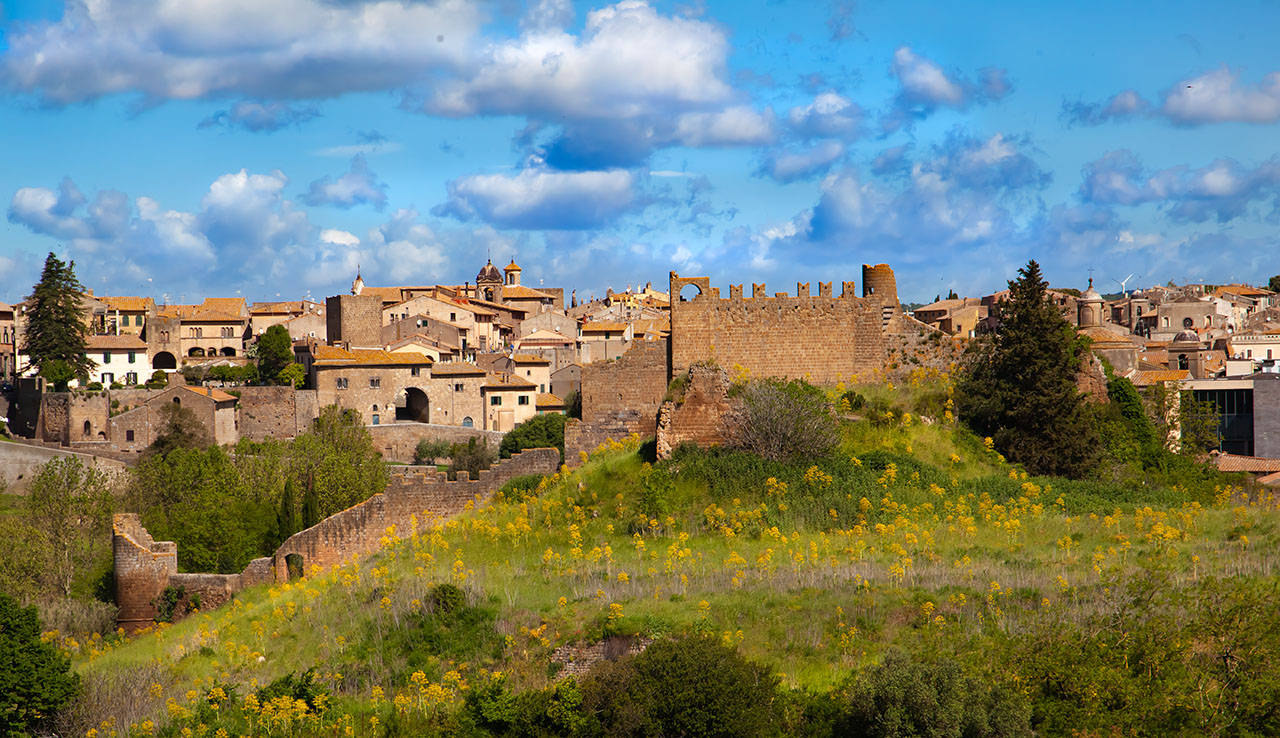
Walk around and behind the Basilica of San Pietro to the terrace and enjoy a magnificent panoramic view of Tuscania whose medieval buildings are embraced by its imposing city walls and the captivating ruins of Castello Rivellino. This evocative vista has remained unchanged for centuries.
4. See the Ancient Roman Archaeological Site
Right across from the Basilica of Saint Peter, you'll encounter an ancient Roman archaeological site.
Regrettably, this site has been neglected and the ruins are mostly obscured by overgrown shrubbery. While the ancient ruins may not be fully visible, they serve as remnants of the significant Roman presence on top of this sacred hill.
A decade ago, when the site was sometimes accessible to visitors and actively maintained, we captured some photos of the ruins, which are included below. Regrettably, as of the current writing, the site has been closed for several years, and there are no available updates regarding potential future restorations or reopening.
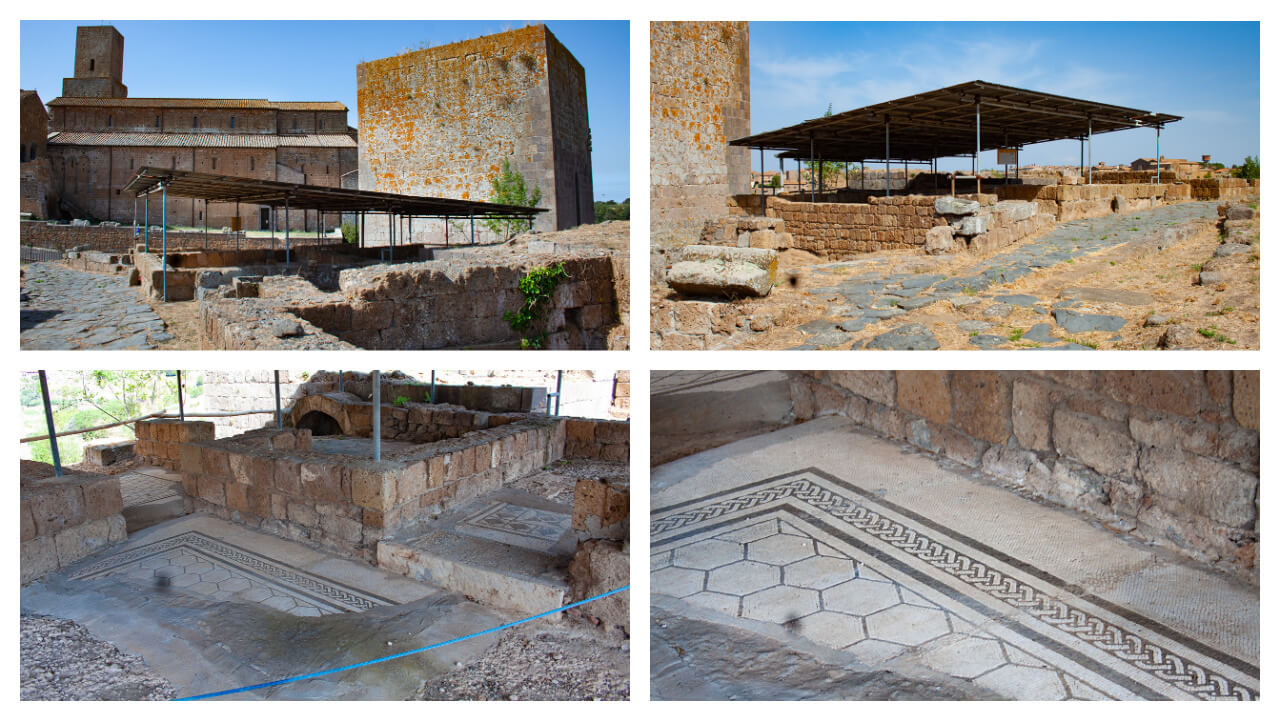
The ancient Roman settlement, strategically located along the Via Clodia from Rome to Saturnia, underwent periods of prosperity and decline. Renewed building activity, including an Augustan-age domus with elaborate decorations, characterized the urban area. Terracing on the southern slope reshaped the landscape.
The site saw continuous habitation until around 400 A.D., followed by a period of stagnation until the 8th century. In the 11th century, a Romanesque basilica and fortified walls were constructed, fostering a renewed urban presence by the 13th century. However, from the 14th century, depopulation set in, concluding definitively in the 15th century. The site eventually became pastoral and cultivated, evolving into a picturesque ruin.
Further down at the junction at the foot of Colle San Pietro are ruins of an ancient late 1st Century BC Roman bathing establishment. A caldarium - a room dedicated to sauna or hot baths - with a mosaic floor can still be identified. Further along, as you will read below, is a segment of an ancient Roman road: Via Clodia
Church of Santa Maria Maggiore
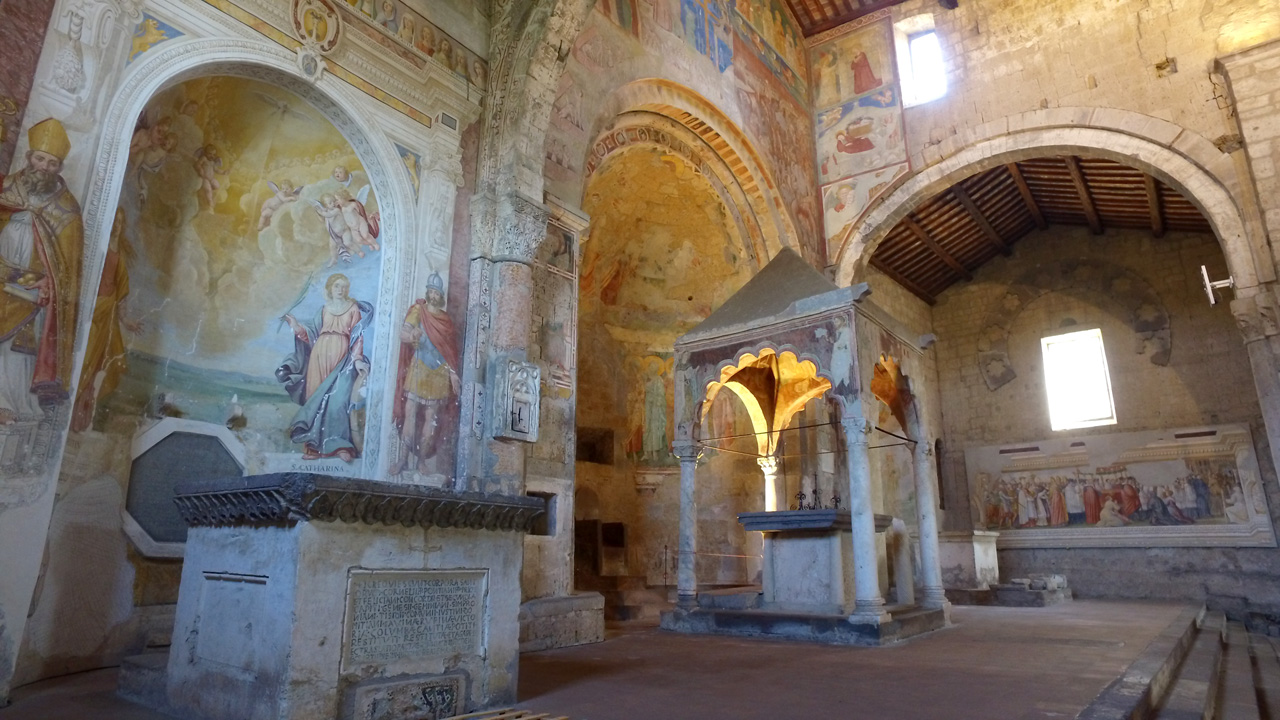
At the foot of Colle San Pietro is another fascinating church: Santa Maria Maggiore. According to art critic Pietro Toesca, the church may have been built in two phases in the late 12th century. Others suggest an earlier date between the late 11th and early 12th centuries. The facade, marked by various influences and interventions, reveals its disorderly history, possibly due to earthquakes. The separate bell tower, dating back to the 12th century, features three finely decorated portals, a rose window, and a semicircular apse.
Inside, the basilica-plan church has three aisles divided by six bays. It boasts painted columns, Romanesque capitals, and blind arches. Notable features include a 13th-century immersion font, a 13th-century ambo, and an altar with a "fenestella" in the left nave. The apse holds a 13th-century fresco of the Twelve Apostles, and the presbytery features a 14th-century Last Judgment fresco attributed to Gregorio and Donato D'Arezzo.
The Church is state-owned and is undergoing restoration with partial visits possible due to the scaffolding in place.
6. Via Clodia - Remnants of Ancient Roman Road
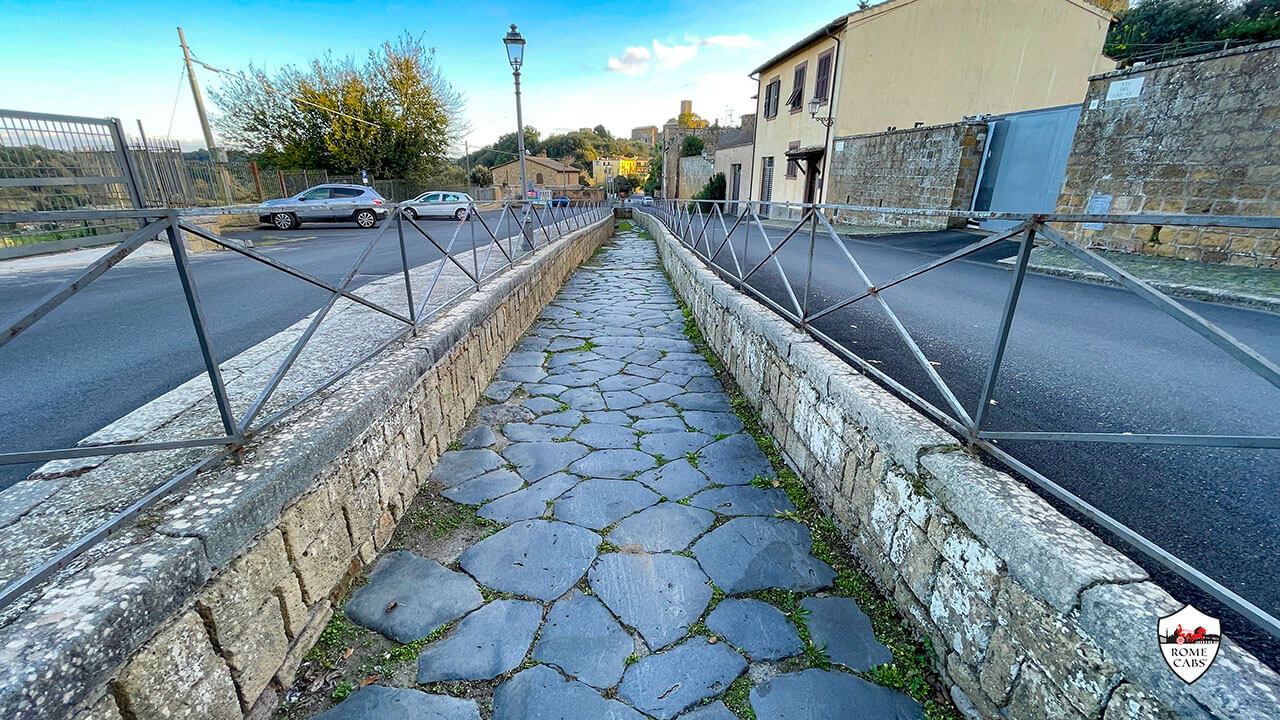
About a block away from the foot of Colle San Pietro, don't miss the opportunity to see a segment of the ancient Roman road, Via Clodia. This well-preserved segment of the ancient Roman road is a testament to the enduring history of the region.
Although this strip of ancient Roman road cannot be walked on, Imagine the footsteps of ancient travelers who once journeyed through this picturesque countryside.
7. Fontana delle Sette Cannelle and Other Fountains
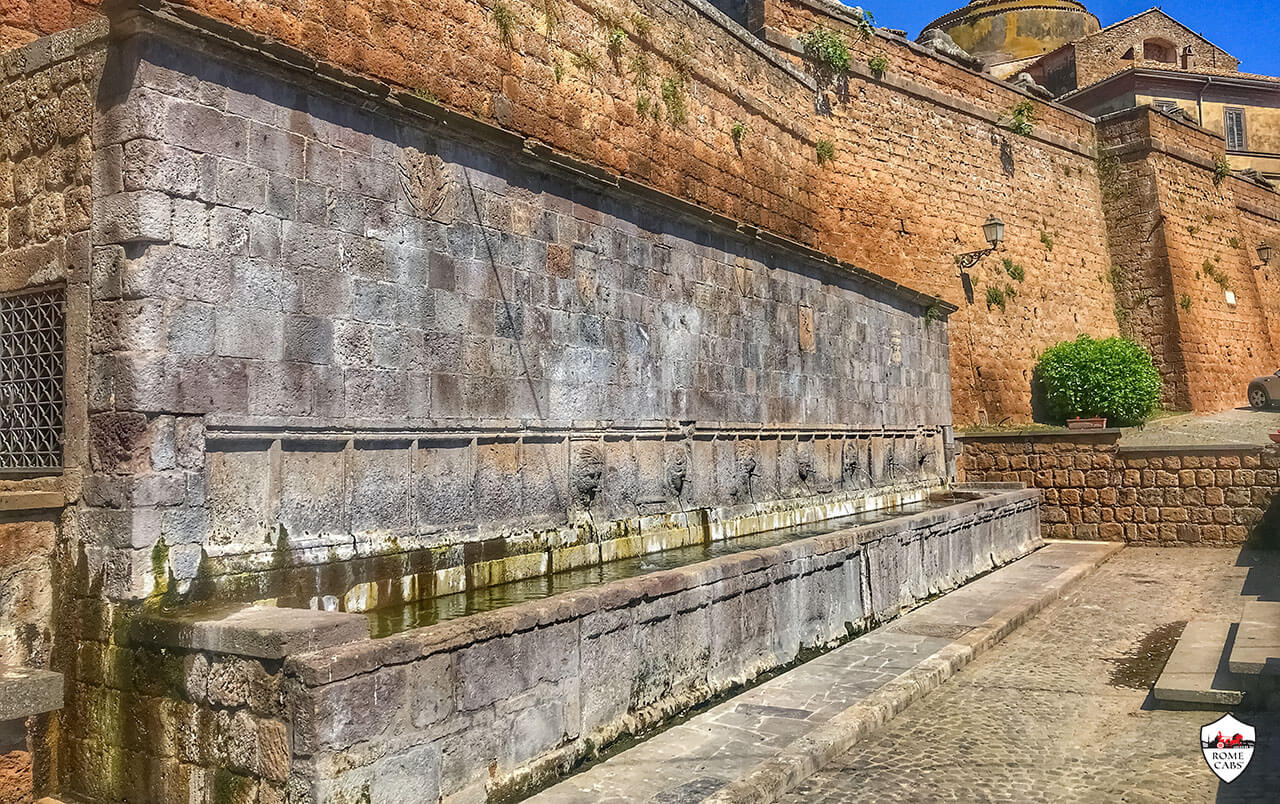
In the quaint square Largo Sette Cannelle in the medieval district of Valle that served as the market square towards the end of the Middle Ages, you'll find the historic Sette Cannelle Fountain, also known as the “Butinale” from the term "bottino" (a small pond) which is located beneath the square.
This name derives from the fact that water flows from the mouths of seven masks. The Fontana delle Sette Cannelle (“Fountain of the Seven Pipes”) is the oldest in Tuscania, dating back to the Etruscan-Roman period. There are seven masks from which water flows, sourced from perennial springs that fed the adjacent gardens, ancient Roman baths, and an olive mill.
The fountain we see today was constructed in 1309, as indicated by the well-preserved Gothic inscription on the facade. It was commissioned by Podestà Lorenzo di Guglielmo (a podestà had judicial, civil, criminal, and administrative autonomy).
The epigraph, also in nenfro, written in Gothic characters describes its founding:
"ANNO DOMINI MILLESIMO CCC NONO MENSE SEPTEMBRIS TEMPORE POTESTARIE DOMINI LAURENTII GUILLELMI DE URBE"
"In the year of our Lord one thousand three hundred and nine, in the month of September, during the tenure of Lord Laurentius Guillelmus of the City"
The inscription SPQR (Senate and the People of Rome, not Tuscania) on the fountain's facade reflects Tuscania's unfortunate submission to the Municipality of Rome until 1354 during that period.
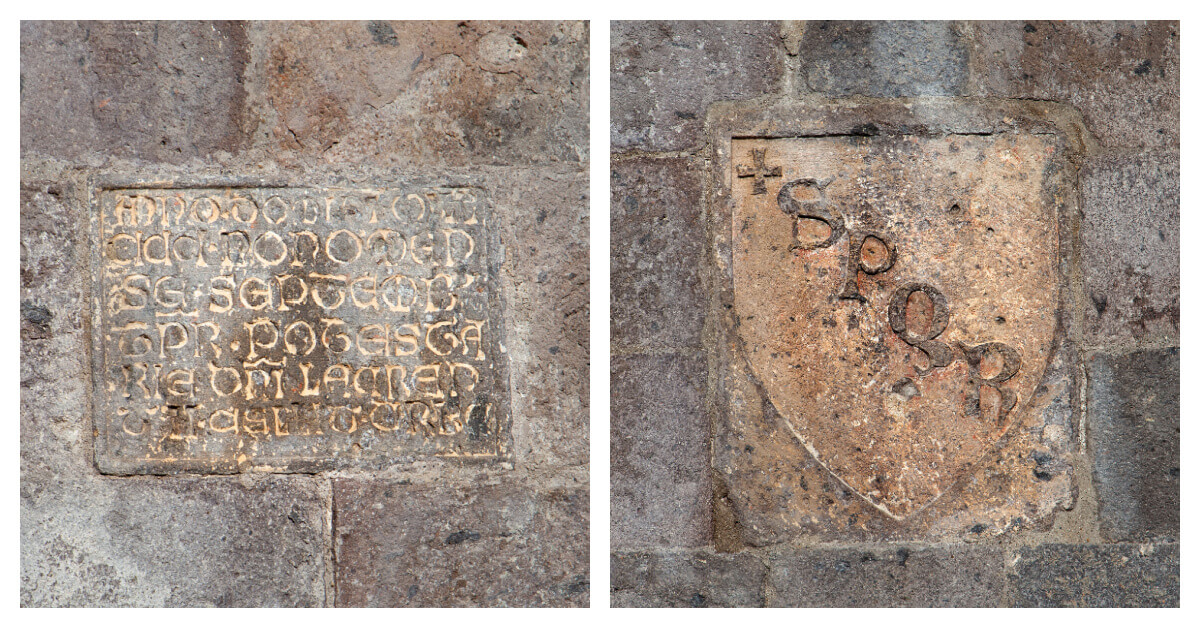
The frontal facade also features coats of arms of Roman noble families who contributed to the restoration and maintenance of the precious fountain over the centuries. Built with the local stones tuff, nenfro, and peperino, the fountain's design suggests a dual function as an animal watering trough and a public fountain for passers-by and the population. Situated near the ancient municipal palace, it was crucial for ensuring water availability, especially during the frequent sieges of numerous wars in the past.
Further up ahead tucked in a corner is an old ”washhouse” fed by a spring that emerged from a tunnel carved into the tuff, testifying to the abundance of water in the Valle district of Tuscania. One can imagine the cheerful voices of women engaged in laundry and exchanging the latest village tidings. The washhouse is part of the city's history, used for washing clothes until the 1950s.
Tuscania’s main square, Piazza Domenico Bastianini, is dominated by the town’s most famous fountain: Fontana Grande (The Great Fountain). This beautiful yet simple 17th-century fountain whose basin was crafted from a single block of stone from a stone quarry near Tuscania, was part of the urban and architectural renewal program promoted by Cardinal Cambara along with the facade of the Cathedral that dominates the square.
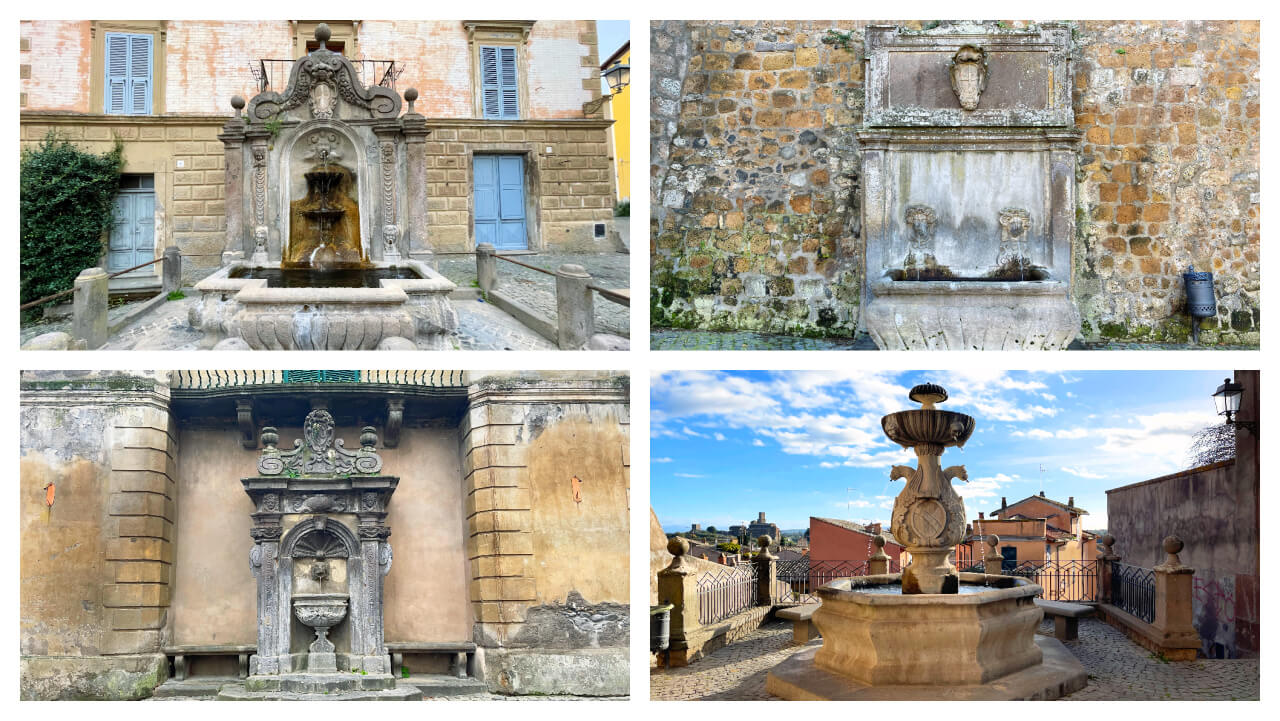
From the central spout and the seven spouts arranged in a circle, water gushed joyfully and fell onto the small basin beneath, then cascading noisily into the underlying large basin. The Sirens, originally supporting a trumpet with their arms (which have now fallen), spouted four jets that gracefully fell into the basin.
Continuing across the square, towards the right of the Cathedral, you'll reach Largo Independenza. Here, a delightful surprise awaits as you encounter the Giannotti Fountain built in 1628, seamlessly integrated into the wall of Palazzo Giannotti.
Similarly, in Piazza Mazzini, the Baroque Montascide Fountain surmounted by the municipal coat of arms is gracefully positioned against the wall of yet another palazzo.
Another historical fountain, Fontana di Sant'Antonio (Fountain of Saint Anthony) is, located outside the city walls and now attached to the walls in Piazza Italia. This fountain was widely used by shepherds to water their flocks during transhumance (seasonal movement of livestock typically sheep, cattle, or goats between fixed summer and winter pastures), as its water fed a long and beautiful trough, similar to those seen in the ancient streets.
8. Parco di Torre Ravello
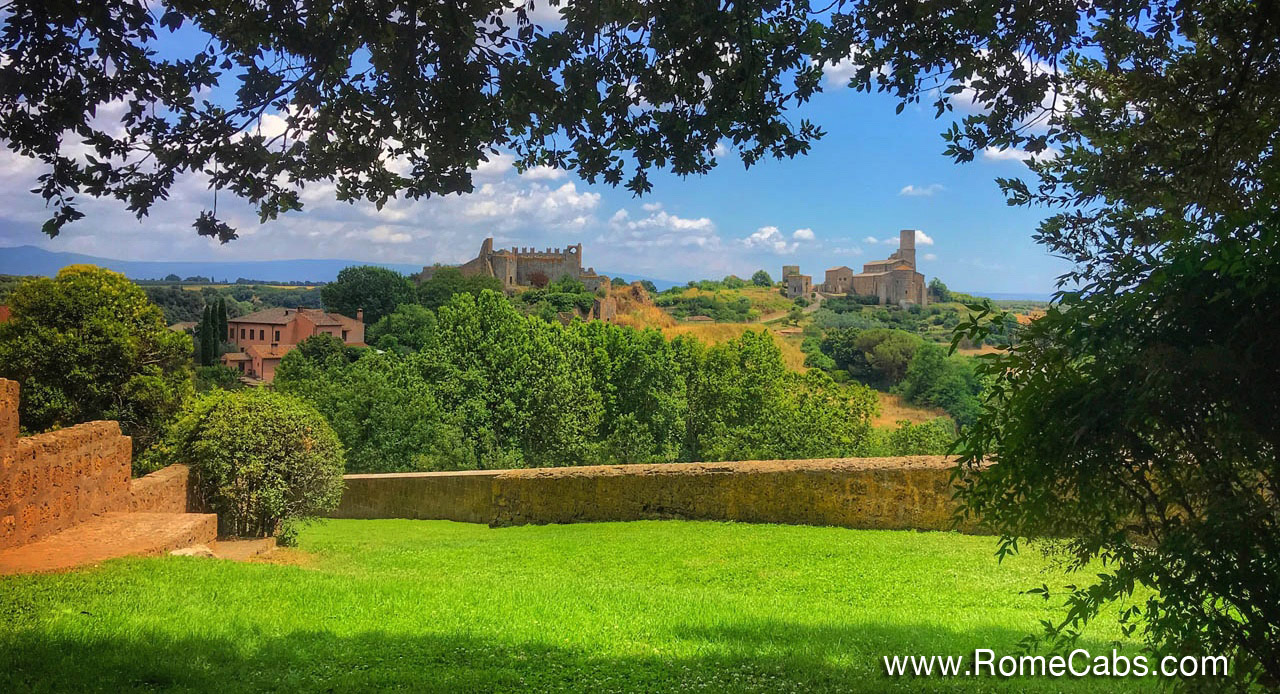
Nature lovers will appreciate the tranquility of Parco di Torre Ravello just off Largo Torre di Lavello Square. Next to the park entrance is the Torre Ravello, a medieval tower with a commanding view of the surrounding landscape.
Here, amidst the greenery of the city park with a small amphitheater and a sundial, you can stroll and relax while enjoying a breathtaking view of the valley studded with the Basilica of Saint Peter and the ruins of Castello Rivellino.
After a sweeping view of the wide open emerald valley of Tuscania, the 19th-century renowned poet and travel book author D.H. Lawrence declared a sentiment shared by many:
“The most beautiful view in all Italy: the Etruscan valley of Tuscania”.
9. See the Ruins of Rivellino Castle
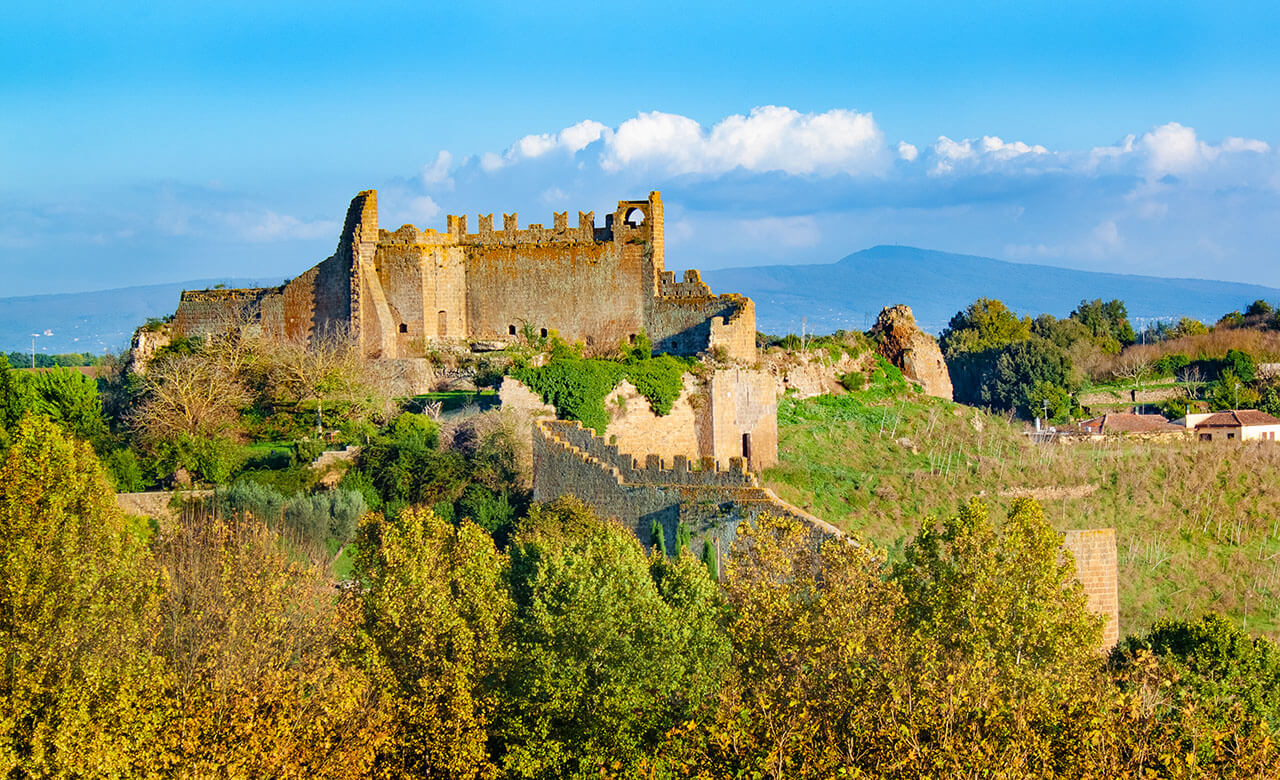
A striking site if viewed from the top of Colle San Pietro and from Parco di Torre Ravello, the ancient communal palace Castello Rivellino, with its high and dominant position, dominated the center of the great medieval Tuscania.
Built during the Ghibelline decade (1253–1263), the fortified palace was divided into three main bodies: the real palace to the east, an arms square to the south, and a fenced-in west-facing area bordering an internal courtyard, where the foundations of two great towers of the twelfth and thirteenth century.
In 1335 Cardinal Albornoz established a town army in Tuscania made up of Pavesati and Balestrieri. Initially used for the Council and the Prior, the palace later served as the Podestà's residence in the late 13th century. By the mid-14th century, additional extensions, including an external fortified enclosure and surrounding wall, transformed the complex into a small fortress, possibly commissioned by the Papal government after Tuscania's reconquest in 1348 by Giovanni di Vico.
However, by 1493, the inevitable degradation of the building prompted the transfer of the Podestà. A few years later, following the sack of the rearguard of Charles VIII, the palace was entirely abandoned. Today, only the southern wall stands as a silent testament to the Ghibelline battles and the historical significance embedded within its stones. This surviving fragment features a superior perimeter walkway, accessible through a circular tower on the shelf—an unparalleled example in central Italy.
10. Visit Tuscania's Archaeological Museum (it’s Free!)
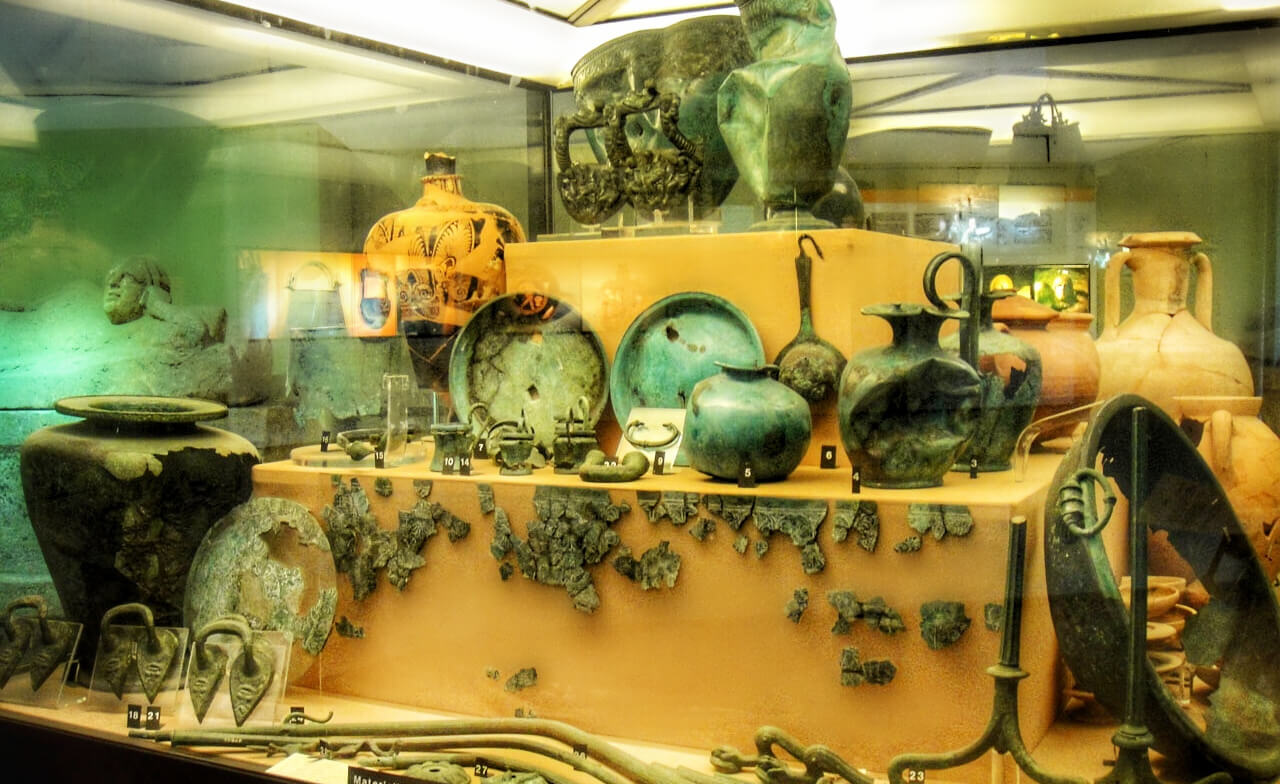
To dive deeper into Tuscania's history, visit the Tuscania Archaeological Museum.
Perched beyond the walls, the church of Santa Maria del Riposo and the former Franciscan convent now houses the National Etruscan Museum. Originally Benedictine, the church underwent Renaissance reconstruction in the late 15th century, adorned with sixteenth-century paintings attributed to Maestro Pellegrino.
The museum reveals Etruscan and Roman artifacts. On the ground floor, artifacts - largely sarcophagi - from the Etruscan tombs of Madonna dell'Olivo and Carcarello necropolises are displayed. The collection offers insights into the lifestyle and appearance of important Etruscan families Curunas and Vipinana from the 4th and 3rd centuries BC.
The upstairs area showcases pottery and a variety of bronze artifacts from armor to kitchen tools from Pian di Mola, Ara del Tufo, and Scalette Necropolises, spanning the 8th century BC to the Roman era. An adjacent room features terracotta architectural elements from the colonnaded portico tomb of Pian di Mola, accompanied by audio-visual explanations.
Museo Archeologico Tuscanese
Largo Mario Moretti 1 - 01017 Tuscania
Opening Hours: Tuesday - Sunday from 8:30 AM to 7:30 PM
Closed on Sundays
Admission: FREE
11. Stroll through the Medieval town of Tuscania
One of the most enchanting experiences in Tuscania is to wander through its beautifully preserved medieval town. The narrow, winding streets are lined with ancient stone buildings adorned with colorful flowers and charming shops.
Meander through the cobblestone alleys, soak in the timeless atmosphere, and discover hidden gems around every corner. This stroll is a step back in time, and every twist and turn reveals a piece of Tuscania's rich history and spectacular views!
In the heart of the medieval town off the main road VIa Rivellino at the corner of Via degli Archi and Via Valle dell’Oro stands the 14th-century Palazzo Tozzi-Spagnoli built by the Toctia family (Tozzi). The palazzo’s facade features a bifora trilobata and a profferlo. The bifora trilobata, a window divided vertically into two openings separated by a column supporting two strong arches, is adorned with a trilobo representing the trinity inside a circle.
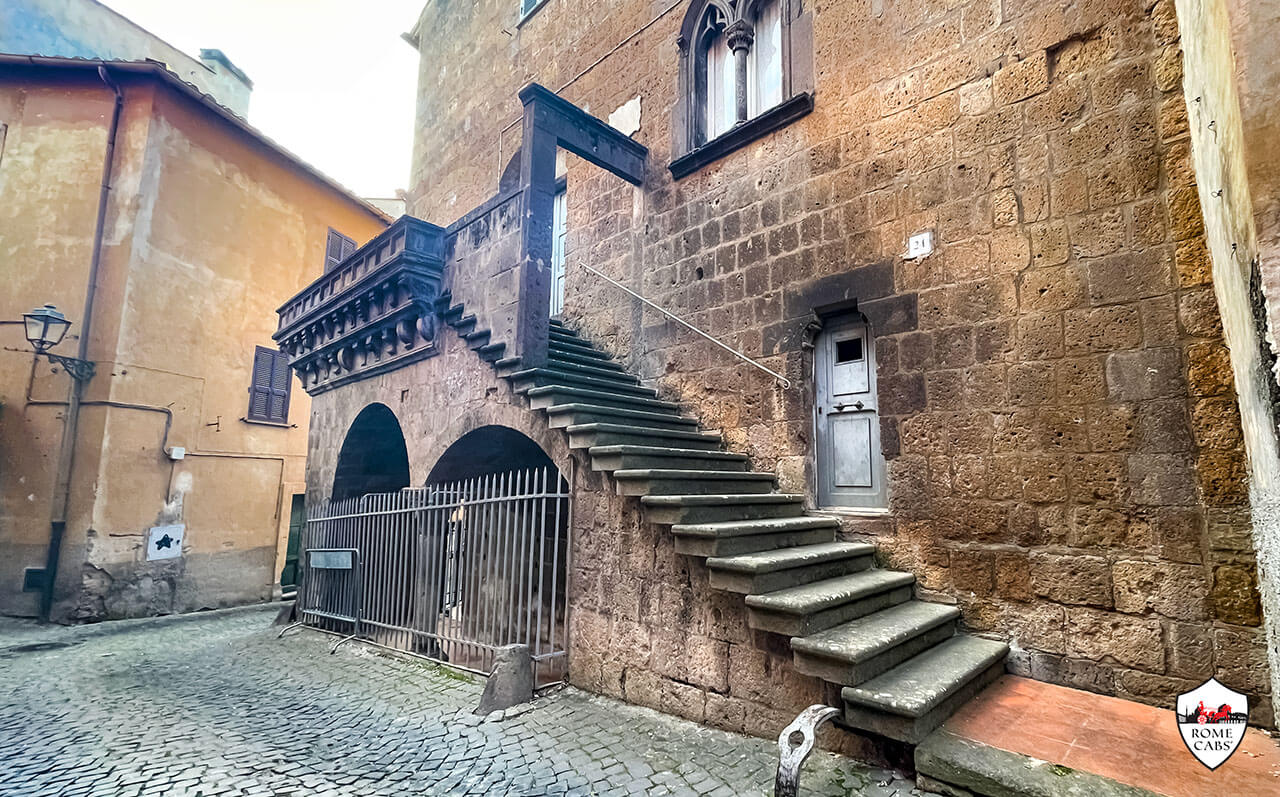
The profferlo architectural element common in medieval houses of Viterbo and in the surrounding area of Lazio features a staircase along its facade that reaches a small loggia before the entrance door to the house. Beneath the staircase, there is a semi-arch, providing access to the ground floor room which in the Middle Ages such a space was typically utilized as a shop, cellar, or occasionally, a stable.
For another breathtaking view, stroll down Via Rivellino to Piazza Franco Basile where the terrace is adorned with ancient Etruscan sarcophagi and offers stunning vistas of the enchanting Medieval buildings beyond, and the Sette Cannelle Fountain below.
From the Sette Cannelle Fountain, head left along the city walls on Via della Lupa towards Torre di Ravello. As you approach the tower, don't forget to turn around and enjoy a breathtaking view of the ruins of Castello Rivellino and the Basilica of San Pietro peeking above the ancient walls.
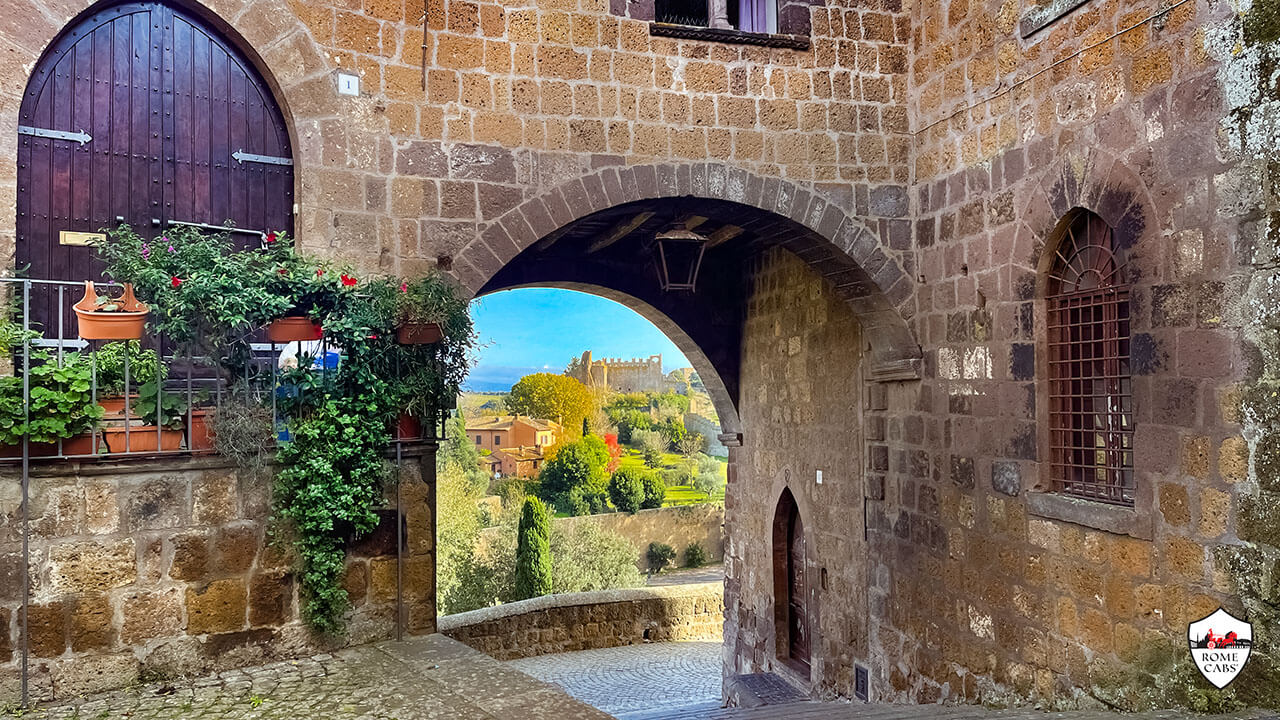
Charming pedestrian lanes with fascinating arches that cross over from one building to another such as Via degli Archi, Via della Torretta, Via Poggio Barone, and Via del Orso, will guide you to enchanting vistas, picturesque medieval buildings, and stone towers that effortlessly transport you to the bygone era of the Middle Ages.
Tuscania's historical center is so well preserved that it has served as the backdrop for historical period films, providing an unparalleled authenticity to cinematic productions seeking a genuine atmosphere.
12. Visit the ancient Church of San Marco
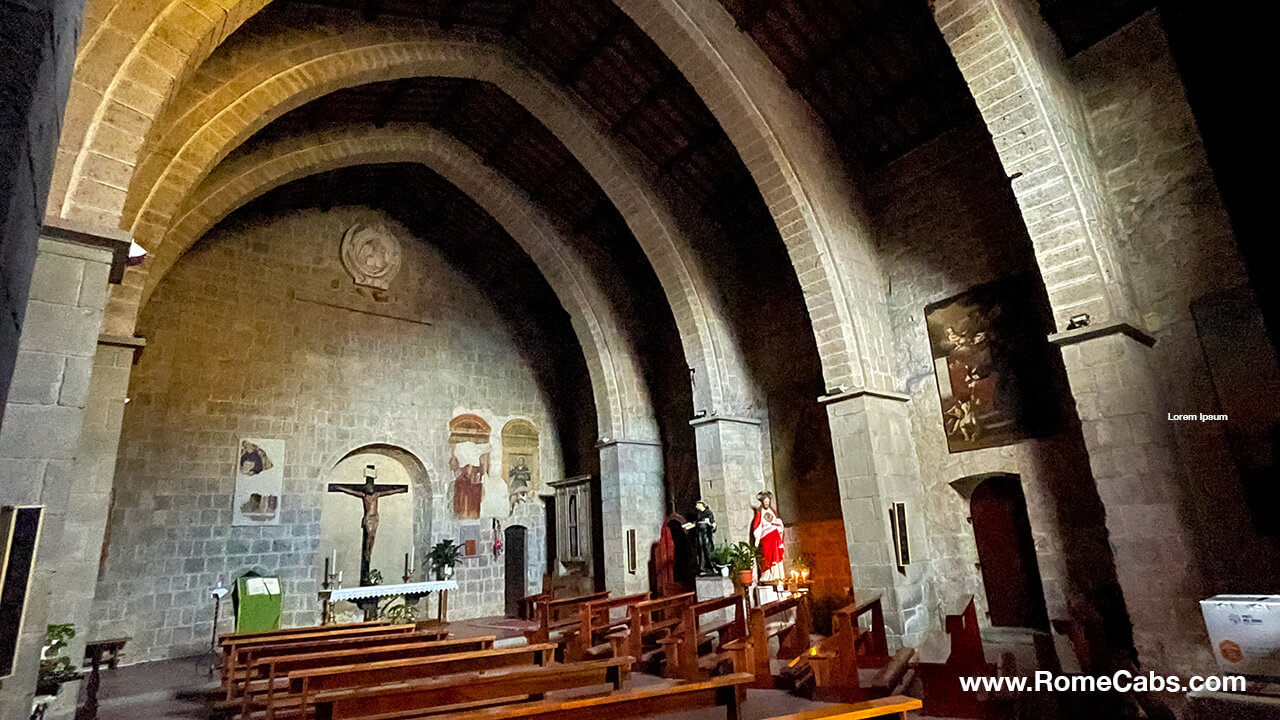
In its unassuming simplicity, this small church with stone walls and dramatic arches provides a window into the grandeur of the Medieval era, offering a sanctuary for spiritual contemplation.
Consecrated in 1333, the Church of San Marco underwent extensive renovations in 1843. Today, the sole remnants of the original structure are found in the entrance portal of the facade, distinguished by thin spiral columns, a 16th-century Madonna and Child in the lunette, and an octagonal oculus above. The trances of a sealed side door and the arch overhead indicate a notable departure from the church's initial architectural configuration.
Following the earthquake in 1971, efforts were undertaken to "liberate" the building and restore its presumed medieval appearance, even though subsequent centuries had significantly altered its original form.
The interior, stripped of later layers of plaster, revealed striking Gothic pointed arches. The open timber truss roof, supported by these arches, provides a dramatic backdrop, enhanced by depictions of the Annunciation and a Madonna and Child within a niche to the left of the inner facade, complemented by depictions of God the Father and Angels above. Behind the high altar, a noteworthy addition is a 15th-century wooden Cross from the Church of Santa Maria del Ripose.
Location: Largo Bixio, just behind Piazza Giuseppe Mazzini
13. Visit the Church of Santa Maria delle Rosa
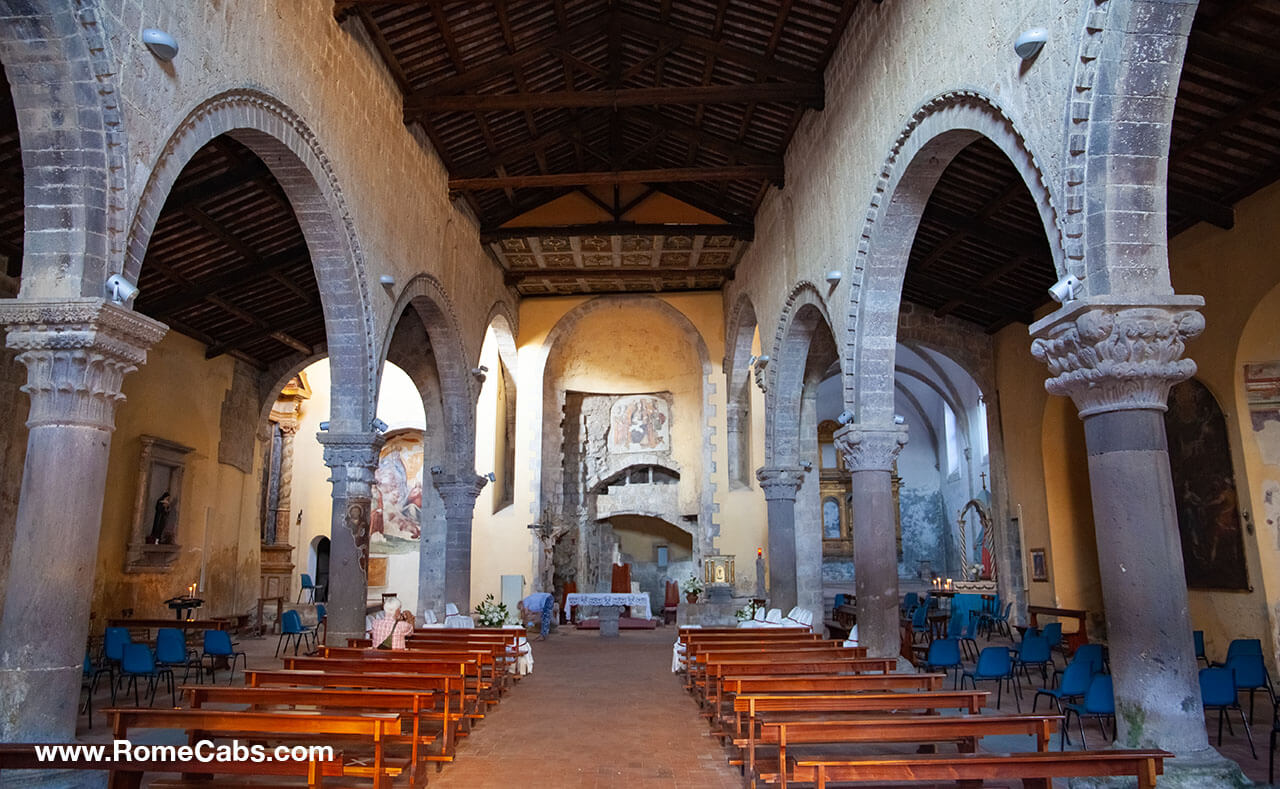
As the St. Peter district experienced a decline, gradually depopulating and being excluded from the perimeter of the new city walls, it eventually became deserted following the sack by Charles VIII's troops in 1495. As a result, the church of Santa Maria della Rosa was elevated to the status of a cathedral.
The current church, with local volcanic stone, is the result of a series of subsequent renovations and expansions, evident in the asymmetries of the plan, the breaks between the different sections visible in the facade, and the stylistic syncretism that sees Gothic elements inserted into a predominantly Romanesque design.
Notable features include a radiant rose window, Gothic-inspired bifores, and a portal with intricate details. Inside, asymmetries and frescoes from the 14th century characterize the interior.
Extensive restorations after a 1971 earthquake revealed pre-existing structures, including an apsed space with 14th-century frescoes, and a detached fresco known as Madonna Liberatrice. The presbytery area holds relics and a 15th-century chapel.
Decorative elements include a Romanesque capital, a 16th-century niche, and a 16th-century arch pinnacle. The church's rich history is showcased through recovered fragments and altarpieces, offering visitors a glimpse into Tuscania's cultural heritage.
Location: Via XII Settembre in Largo della Rosa (about a block from the Church of San Marco)
- NOTE: this church is not always open. But as it’s located so close to San Marco in the beautiful medieval center it merits a stroll just in case you find it open for visitors.
14. Dine in Tuscania
A trip to Tuscania wouldn't be truly fulfilling without experiencing its culinary wonders. The town boasts an array of inviting trattorias and restaurants, providing the perfect opportunity to relish authentic Italian cuisine.
The presence of Etolie Academy Cucina, one of Italy's leading culinary schools, adds to Tuscania's reputation for excellence in dining, making it a standout destination for those seeking a delightful gastronomic experience.
Taste local specialties like handmade pasta, fresh seafood, and mouthwatering desserts. Pair your meal with a glass of regional wine for a true Tuscanian experience.
Excellent restaurants to try in Tuscania are:
- La Torre di Lavello - Via Torre di Lavello, 27
- Cichi’s RisoBistro - Strada Santa Maria
- I Tullipani - Largo della Pace, 10
- Ristorante Le Cime 2 da Maria - Largo Sette Cannelle
15. Shop for fine reproductions of Etruscan Ceramics
For a unique memento of your visit to Tuscania, consider purchasing museum-worthy Etruscan-imitated ceramics crafted by local artisans who specialize in this ancient tradition.
These Etruscan museum-inspired reproductions are celebrated for their exquisite craftsmanship and intricate designs. You'll find a variety of pottery from pottery bowls to drinking goblets, Kylix for drinking wine, Hydria vases used to fetch water, or amphora that once held liquids or grains.
Etruscans produced a variety of other pottery types, each with its distinctive characteristics and purposes. Some of the notable types of Etruscan pottery that are displayed in museums and reproduced by skilled artisans that would add to your home decor and make great conversation pieces include:
Black-Figure Pottery: Inspired by Greek pottery styles, Etruscan black-figure pottery involved the use of black slip (liquid clay) to create dark figures on a red clay background. This technique was prevalent in the 6th century BCE.
Red-Figure Pottery: Similar to black-figure pottery, red-figure pottery featured red figures against a black background. This technique allowed for greater detail and flexibility in depicting figures. It became popular in the later Etruscan period.
Bucchero - a distinctive type of Etruscan pottery that was produced from the 7th to the 5th century BC and characterized by its dark color, often black or dark brown, and a shiny, metallic finish. Bucchero ware was typically wheel-thrown and then fired in an oxygen-starved kiln, which prevented the complete oxidation of the clay and resulted in the characteristic dark color.
Krater: Kraters were large, wide-mouthed vessels used for mixing wine and water. They often had decorative scenes, including mythological or everyday scenes, and were a common form of Etruscan pottery.
Askos: Askos pottery had a distinctive spout and handle, often shaped like an animal head. These vessels were used for pouring liquids and were sometimes decorated with intricate designs.
Kantharos: Kantharoi were deep, bowl-like vessels with high vertical handles on each side. They were often used for drinking and were decorated with various motifs.
Oinochoe: Oinochoai were jug-like vessels with a single, often elaborate, handle. They were used for pouring wine and had various shapes and sizes.
Kylix: Kylixes were shallow drinking cups with horizontal handles and a stemmed base. They were often decorated with scenes related to Dionysian themes or daily life.
These authentic museum pieces make for exceptional souvenirs or gifts, connecting you with the town's artistic heritage.
Shops that specialize in hand-crafted reproductions of Etruscan vases in Tuscania are:
- Souvenir Kiosk next to Basilica of San Pietro
- Keramos - Via Roma, 14
- Danella Elisa Arte Etrusca - Via Fabio Filzi, 4
Tuscania stands as a captivating treasure trove of history and culture, inviting travelers to embark on a journey through time. From the ancient Etruscan origins to the Medieval splendor encapsulated in its churches and formidable defensive walls and towers, every cobblestone street tells a tale of a bygone era. As you explore the best things to see and do in Tuscania, you'll find yourself immersed in a living museum of art, architecture, and the rich tapestry of Italian heritage.
Whether you're a history enthusiast, an art aficionado, or simply seeking the tranquility of the Italian countryside, Tuscania has something remarkable to offer, and RomeCabs is your key to unlocking its treasures.
Our Italy tours from Rome or Shore Excursions from Civitavecchia to Tuscania offer a seamless and enriching adventure through Tuscania's cultural gems but also the convenience of exploring the surrounding countryside such as Tarquinia and Bracciano on our Mysterious Etruscans Tour and Medieval Magic Countryside Tour.
Let RomeCabs be your gateway to the wonders of Rome’s countryside that await your exploration in comfort and luxurious style. Visit our Rome Countryside Tours on our website and book your preferred Rome Countryside Tour or Shore Excursion from Civitavecchia to Tuscania and other captivating countryside destinations.
